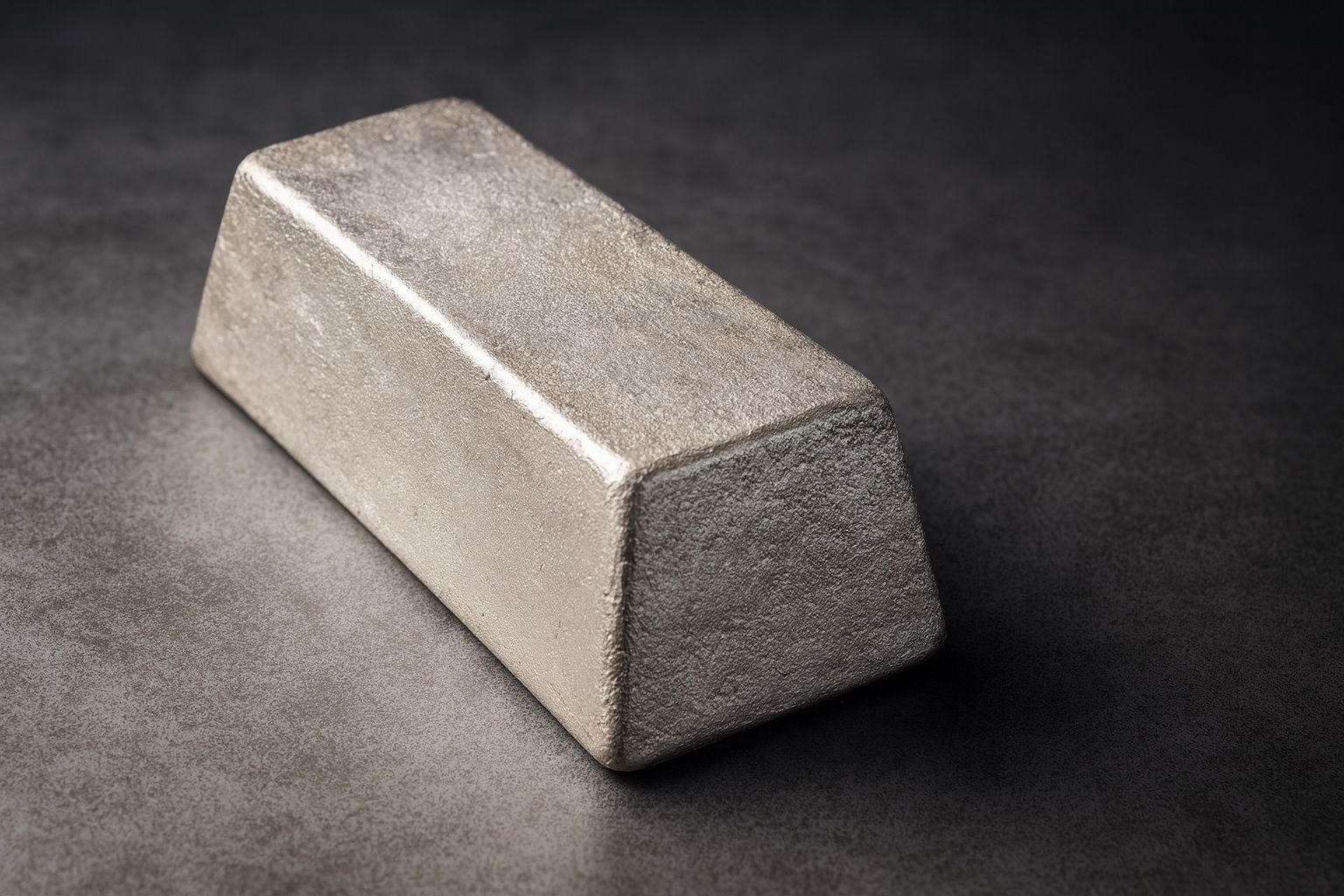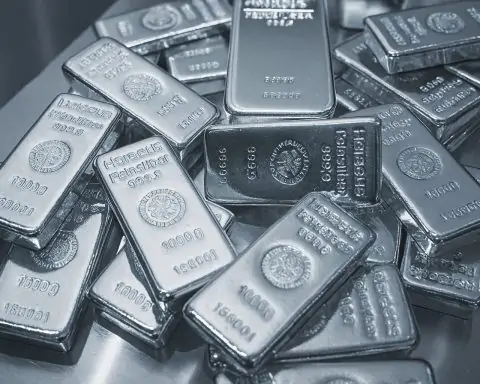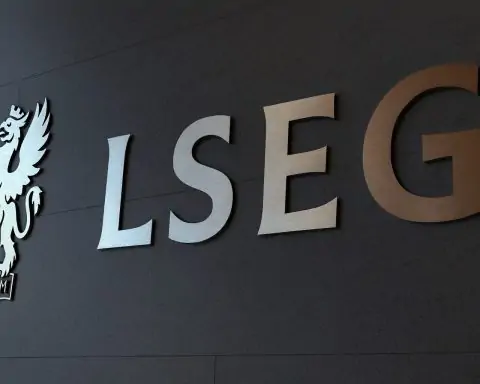- Silver slips from recent records: Spot silver is trading around $47.8 per ounce on October 27, 2025, down about 1.6% from last week’s close [1]. This comes shortly after silver hit an all-time high near $54.5/oz in mid-October before a sharp pullback [2].
- Staggering 2025 surge: Even after its pullback, silver remains up roughly 65–70% year-to-date, vastly outperforming most assets (gold is up ~60%) [3] [4]. The metal’s rally accelerated this month as it soared past $50 for the first time since 1980, then briefly reached record levels before profit-taking set in [5].
- Gold’s parallel rally: Sister metal gold smashed records above $4,300/oz in October amid the safe-haven frenzy [6]. Gold has since eased back to the ~$4,000 level, with the gold/silver ratio now around 84 (meaning it takes 84 ounces of silver to equal one of gold) [7]. Both metals have been lifted by investor anxiety over wars, inflation, and a potential Fed policy pivot.
- Market drivers “perfect storm”: Analysts cite a confluence of factors fueling silver’s rise – geopolitical tensions, inflation and currency debasement fears, expectations of Fed interest rate cuts, a weaker U.S. dollar, booming industrial demand, and tight supplies [8]. Recently, hints of easing trade tensions and upbeat economic news temporarily cooled the rush into safe havens [9].
- Industrial demand & supply crunch: Over 50% of silver demand now comes from industry, with 2025 on pace for a record ~700 million ounces used in solar panels, electronics, electric vehicles, and other tech [10]. Mine output isn’t keeping up – about 835 Moz is expected this year (slightly down from prior years), leaving a structural deficit for the fifth year in a row [11] [12]. Major producers like Mexico and Peru face political, labor and environmental hurdles that constrain new supply [13].
- Volatility here to stay: Silver’s history of boom-and-bust is on full display. After its steepest one-day drop in six months (–6% on Oct 17) [14], the metal remains volatile. “It appears we have a short-term top at $54,” one analyst said after silver’s swoon, “and while sentiment wobbles under $50, [silver] is likely to trade sideways with substantial volatility” so long as gold stays firm [15]. Investors are bracing for continued price swings as markets digest every new economic and geopolitical signal.
Silver Price Snapshot – Oct 27, 2025
As of midday October 27, spot silver hovers around $47.8 per troy ounce, easing from last week’s levels [16]. The metal is down about 1.6% from Friday’s close but is still up an astonishing ~65% since January [17] [18]. In other words, an ounce of silver costs nearly two-thirds more today than it did at the start of 2025 – a testament to how dramatically this year’s rally has reshaped the market.
Why the surge? In 2025 silver has benefited from a rare mix of bullish factors. It’s both a precious metal (like gold, prized in times of uncertainty) and an industrial commodity (used heavily in electronics and green energy). That dual nature means silver drew in waves of safe-haven investors this year while manufacturing demand stayed robust. The result: prices climbed relentlessly through the year, recently reaching levels not seen in decades.
Mid-October highs: The rally hit a peak on October 16, when silver briefly spiked above $54/oz – vaulting past its 2011 record (~$49.50) to set a new all-time nominal high [19]. That day marked the first time since 1980 that silver traded over the $50 benchmark, a psychologically important level long considered a ceiling. By October 17, silver settled back to the low-$50s [20], and it has since continued to cool off into the high $40s. Even so, at current ~$48 levels the metal is nearly double its price from two years ago and remains one of 2025’s top-performing assets.
Wild Swings: From Record Rally to Pullback
Silver’s price action in recent days can only be described as a rollercoaster. In the first half of October, prices rocketed upward almost vertically. Fueled by frantic safe-haven buying, silver blew past the $40s, neared $50 by early October, and then burst through $50 with astonishing speed. On Oct 16, amid a frenetic precious-metals rally, silver jumped as high as $54.50/oz intraday – an all-time record [21]. It ended that week around $52, up more than 70% year-to-date [22].
But the euphoria was followed by a jarring reversal. Profit-taking hit hard on Oct 17, knocking silver down about 6% in a single session [23] – the steepest one-day plunge in six months. Traders who had chased the rally hurried to lock in gains once the legendary $50 level was breached. At the same time, a few hopeful signs on the geopolitical front started to calm nerves: for example, hints of a U.S.–China trade truce and easing war headlines dulled the sense of panic that had been driving haven buying [24]. With a bit of optimism creeping back into markets, fear-driven demand for metals cooled, at least temporarily.
By October 20, volatility was in full swing. Gold, which often leads the precious pack, spiked to fresh record highs above $4,380/oz that Monday [25]. Silver likely piggybacked on that final burst of haven demand – only to “swoon” the next day, dropping about 7% as momentum abruptly shifted [26]. “Silver is stumbling badly today and has dragged the entire complex lower,” one analyst observed during that Oct 21 sell-off [27]. It appeared $54 was the short-term top. Indeed, silver fell back into the $48–49 range [28], erasing the late-stage blow-off gains but still remaining well above its pre-rally levels.
Since then, the metal has been range-bound in the upper $40s, suggesting a market trying to find equilibrium after a dramatic run. Sentiment has turned more cautious: each time silver nears $50 again, sellers emerge, yet dips into the mid-$40s have also attracted bargain hunters. “While sentiment wobbles under $50, silver is likely to trade sideways with substantial volatility as long as gold remains relatively firm,” notes one commodities strategist, framing the choppy outlook going forward [29]. In short, the market is catching its breath – but could still swing sharply on the next news jolt.
Gold and Other Commodities Riding the Wave
Silver’s fate is tightly interwoven with gold, and 2025 has been no exception. Gold’s epic rally this year set the tone, and silver followed in its slipstream. In early October, gold shattered its own records – blasting above $4,000/oz for the first time and even hitting an intraday peak around $4,381 on Oct 20 [30]. At one point gold was up roughly 60% year-to-date [31], an extraordinary rise for the world’s benchmark precious metal. This explosive move in gold lent credibility to the idea that a major safe-haven rush was underway, encouraging investors to pile into silver as the “cheaper” alternative. “Gains in gold attract ancillary buying in silver,” analysts at HSBC noted, explaining how gold’s record run pulled silver higher in tandem [32] [33].
By mid-October, the two metals were hitting historic highs together – truly a precious metals mania. The gold/silver ratio, a classic measure of their relative value, compressed dramatically as silver outpaced gold’s gains [34]. The ratio tightened to around 82:1 at one point (from over 100:1 last year) [35], meaning silver became much less undervalued versus gold than it had been. As of Oct 27, the ratio sits near 84:1 [36], reflecting gold around ~$4,020 and silver ~$48 per ounce. This is still a historically low ratio, highlighting how strong silver’s run has been compared to gold in recent months.
Other commodities: The flight to safety lifted not just gold and silver but also other precious metals. Markets like platinum and palladium saw sympathetic spikes – at one point in mid-October platinum jumped ~5% to ~$1,660 and palladium ~6% to ~$1,495 [37] as investors bought into the whole precious metals complex. Even industrially-oriented metals benefited from the broader commodity upswing earlier in the year. That said, silver and gold have been the clear standouts thanks to their monetary haven appeal.
Notably, oil prices and base metals have had a more mixed influence. High oil prices earlier in 2025 stoked inflation fears (bullish for gold/silver as hedges), but more recently easing energy costs and steady base metal supplies have helped calm some inflation angst. For silver, which straddles the line between precious and industrial, stable copper or oil prices can be a double-edged sword – reducing production costs for miners (a positive), but also signaling less immediate inflation risk (which can dampen urgency for havens). Overall, though, the dominant factor has been gold’s trajectory. As gold goes, so goes silver: when gold finally cooled off and pulled back from its highs, silver promptly did the same [38]. For investors, keeping an eye on gold’s direction and the gold/silver ratio will be key to gauging silver’s potential moves ahead.
Market Sentiment and Economic Signals
Beyond the headlines of record prices, silver’s wild ride has been driven by shifting economic currents and market sentiment. In many ways, 2025 has been the year that the macro stars aligned for precious metals:
- Inflation and currency worries: Persistent inflation and fears of currency debasement have been a major tailwind for silver (and gold). Although inflation has come down from its post-pandemic peaks, it’s still running above central bank targets in many countries. In the U.S., for instance, consumer prices are rising around 3% year-on-year – much lower than last year’s highs, but still enough to erode purchasing power [39]. This, coupled with massive government spending and debt, has fueled concern about the long-term value of fiat money. Investors often turn to hard assets like silver as an inflation hedge. Indeed, silver’s surge partly reflects a flight from paper currency into tangible stores of value. The U.S. dollar’s performance also factors in: earlier in 2025 the dollar index weakened, which made dollar-priced commodities like silver cheaper for overseas buyers and helped lift prices [40]. (Lately the dollar has steadied, and any renewed dollar strength could cap silver’s upside.)
- Interest rates and the Fed: Perhaps the biggest macro catalyst has been the outlook for interest rates. After an aggressive rate-hiking cycle in 2022–2023, the U.S. Federal Reserve signaled a pivot in 2025 as economic growth cooled. Markets are now widely expecting the Fed to cut rates, possibly starting at the upcoming policy meeting at the end of October [41] [42]. Such expectations have turbocharged precious metals. Silver and gold pay no interest or dividends, so they tend to shine when interest rates peak or fall – the opportunity cost of holding them drops. All year, anticipation of imminent Fed easing has been a key driver behind gold’s climb [43], and by extension silver’s. Conversely, when bond yields tick up (as happened briefly after some strong economic reports in mid-October), silver and gold often face pressure [44]. For now, the prospect of lower rates and easier monetary policy is providing a safety net under precious metals. Traders are laser-focused on Fed signals: a confirmed rate cut could spark another rally, whereas any hawkish surprise might spook the market.
- Risk appetite and equities: The dynamic between stock markets and silver is another piece of the puzzle. Earlier in October, global equities wobbled – weighed down by high rates and geopolitical worries – which pushed more money into safe havens. However, in late October we’ve seen periodic rebounds in stocks as fears ebbed (for example, after strong corporate earnings or hopeful geopolitical news) [45] [46]. These “risk-on” bursts can sap demand for havens. As one analyst noted, “better risk appetite… is bearish for the safe-haven metals” [47]. A prime example was Oct 21: U.S. and Asian stocks jumped on optimism about trade talks and tech earnings, and simultaneously gold/silver fell sharply [48]. The takeaway: silver is sensitive to the overall market mood. It often acts as the inverse of confidence – thriving on fear, sagging on complacency. With volatility returning to stocks this autumn, swings in sentiment have translated into see-saw trading in silver. Many investors are essentially hedging their bets: loading up on silver and gold as “insurance” against any equity downturn or macro crisis [49], then taking profits when calm prevails.
- Key indicators to watch: In the weeks ahead, a few benchmarks could sway silver notably. One is the inflation data – any surprise uptick in price indexes might rekindle inflation hedging demand [50]. Another is central bank actions and commentary: besides the Fed, the European Central Bank and others are being watched for signs of policy easing, which would be precious metal-positive. Currency moves (especially USD and Chinese yuan) are crucial too. And of course, the ebb and flow of major geopolitical headlines – war, trade disputes, political instability – can send investors alternately rushing into or out of safe havens. In short, silver’s price is at the mercy of a complex mix of macro forces, making it a barometer of both economic confidence and anxiety.
Industrial Demand: Silver’s High-Tech Role
Unlike gold, silver’s fortunes aren’t tied solely to financial markets or investor sentiment. Silver is often called “the indispensable metal” for modern industry – and soaring industrial demand is a big reason why the silver market’s fundamentals look so strong. In 2025, industrial uses are expected to account for over half of total silver demand [51], a proportion that has been rising steadily with each passing year of the tech boom and green energy transition.
Green energy powerhouse: The solar power industry is now the single largest driver of silver consumption. Silver’s superior electrical conductivity makes it a key component in photovoltaic (PV) solar panels. As countries race to expand renewable energy, solar panel production has boomed – and so has silver usage. In 2024, the solar sector alone gobbled up an estimated 232 million ounces of silver (up from just 60 Moz a decade ago) [52], and 2025’s total is climbing further. Every new solar installation, from rooftops to vast solar farms, contains a small but crucial amount of silver. Likewise, the push for electric vehicles (EVs) is boosting silver demand: EVs and their charging infrastructure rely on silver in components like conductors, switches, and fuses. As one market observer put it, “silver is indispensable in today’s technology-driven world”, used in everything from *5G telecom equipment and semiconductors to medical devices and batteries [53].
Beyond the green revolution, silver remains vital for countless electronics (smartphones, computers, appliances) due to its high conductivity. It’s also used in high-end brazing alloys and solders, in LED lighting, in touch screens, and even in antibacterial coatings for healthcare. This broad-based demand means that even if investment demand for silver ebbs at times, factories and tech firms still require an ever-growing supply of the metal to build the modern economy.
Tight supplies and deficit: The flip side of robust industrial appetite is that supply has struggled to keep up, contributing to a structural deficit in the silver market. Most silver comes from mines, but interestingly only about 30% of silver mines are “primary” producers – the rest is a byproduct of mining other metals (like lead, zinc, or copper) [54] [55]. That makes silver supply somewhat inelastic; even a price surge doesn’t instantly boost production, since you can’t quickly ramp up copper mines just to get more silver byproduct. In 2025, global mine output is forecast around 835 million ounces, actually a bit lower than in recent years [56]. Major silver-producing countries are facing challenges: Mexico (the world’s #1 silver producer) and Peru (#2 producer) have seen political instability, labor strikes, and stricter environmental rules that have slowed new mining projects [57]. Other top producers like China and Russia are likewise not significantly increasing output. Recycling of silver (from scrap electronics or jewelry) provides some additional supply, but it’s nowhere near enough to fill the gap [58].
The result is a notable supply/demand mismatch. For the fifth consecutive year, the silver market is in deficit – meaning yearly demand exceeds the total new supply mined and recycled [59]. Estimates for 2025’s shortfall range from around 117 million ounces up to 200+ million ounces [60] [61], depending on the source, which is a historically large gap. These deficits have been drawing down above-ground inventories and contributing to the bullish undertone in silver prices. For example, silver exchange-traded funds (ETFs) that hold physical metal have seen steady inflows; at one point this year, total ETF silver holdings swelled to over 1.13 billion ounces globally [62]. That’s essentially metal being taken off the market into long-term storage by investors.
High-tech demand vs. high prices: One interesting dynamic to watch is how industrial users cope with such high silver prices. Manufacturers generally prefer stable, low input costs – a sudden doubling of silver prices can squeeze profit margins for solar panel makers or electronics firms. There have been efforts to thrift or substitute silver in some applications (for instance, using less silver per solar cell, or testing copper-based alternatives). So far, these measures have only marginally reduced silver usage, as the sheer growth in demand has swamped any per-unit savings [63]. If prices stay elevated above $50, some industries like jewelry or silverware might see demand dip (consumers balk at expensive silverware) [64]. But critical sectors like electronics and energy are unlikely to pull back much – they need silver, and there aren’t many good substitutes for its unique properties. Analysts believe any small dip in discretionary silver use would be offset by continued growth in tech and renewable energy applications going forward [65].
In summary, silver’s industrial story provides a solid fundamental backbone to the market. It’s not just about speculators or economic panic; there is genuine physical demand growth underpinning the price. One commodities research firm projects that if current trends continue, the silver shortage could intensify, potentially leading manufacturers and investors into competition for available supply [66] [67]. This underlies why many bulls see long-term value in silver even beyond the current geopolitical drama – the world’s technological and clean-energy ambitions are literally built on silver.
Geopolitical Influences and Supply Risks
Global politics have always had a say in precious metal markets, and 2025 has offered plenty of geopolitical intrigue affecting silver, both on the demand side and the supply side.
On the demand side, geopolitical turmoil has been a prime driver of safe-haven flows this year. The ongoing war in Ukraine and a sudden flare-up of conflict in the Middle East (including a major crisis in Israel/Gaza in October) have kept investors on edge [68]. Each new headline of escalation tends to send worried money into gold and silver. Political instability elsewhere – from tensions in U.S.–China relations to unrest in parts of Europe – further adds to a climate of uncertainty. Precious metals often thrive on the “fear trade,” and unfortunately 2025 has not been short on global fears. This is why we’ve seen periods where silver and gold spiked in tandem with bad news. Conversely, when there are glimmers of diplomacy or peace (for example, talk of a U.S.–China summit or ceasefire negotiations in conflict zones), safe-haven demand can fade quickly [69]. Silver’s mid-October pullback, for instance, was partly attributed to an easing of immediate war fears and hopes for a trade truce between major powers [70].
Meanwhile, on the supply side, geopolitical and policy factors in key mining countries directly impact how much silver comes out of the ground. Take Mexico, which produces roughly a quarter of the world’s silver. Recent policy changes there – such as a mining law reform tightening environmental rules and shortening concession lengths – have introduced caution for mining investors. While Mexico’s output actually ticked up ~2% in 2024 after a few years of declines [71], analysts warn that if regulatory burdens increase or if there’s political shift toward resource nationalism, it could crimp future production. Peru, the #2 silver producer, has had its share of tumult as well. The country dealt with major political upheaval in 2022–2023 (including a presidential crisis and protests) that disrupted some mining operations. Although Peru’s mining sector is recovering, sporadic labor strikes and community protests over mining projects remain a risk factor. Any significant disruption in either Mexico or Peru can quickly tighten global silver supply.
Other notable producers include China, Chile, Australia, Russia, and Poland. China’s focus on environmental regulation and cracking down on heavy industries has sometimes limited its metal output growth. In places like Chile and Argentina, high inflation and political shifts could affect mining investment. Russia is a large silver source (mostly as a byproduct of gold mining) – geopolitical isolation and sanctions in the wake of its conflict with Ukraine haven’t severely hit its silver exports yet, but it’s something the market watches. And in Poland (home to Europe’s huge copper-silver mines), there’s been talk of tax changes on mining companies that could influence production levels.
One emerging concern is that some governments, seeing high precious metal prices, might impose higher royalties or even consider export restrictions to capitalize on the boom or secure domestic supply. There’s precedent in other commodities (like countries banning exports of certain ores), though nothing concrete in silver so far. Trade policies also matter: for instance, if a trade war escalated and affected industrial components, that could indirectly hit silver usage in electronics or solar products.
All told, geopolitical developments form a backdrop of constant uncertainty. For now, they’ve largely worked in silver’s favor by elevating its allure as a safe asset. But they also inject risk – a sudden peace deal or defusion of a major crisis could deflate the safety premium in prices. Conversely, any new shock (say, a financial crisis, or escalation of a conflict involving major powers) could spur another leg up for silver as a crisis hedge. Supply-wise, investors are monitoring major silver nations for signs of resource policy changes or unrest that could pinch output. It’s a reminder that silver’s value is shaped not just by economics, but by the actions of governments and events on the world stage.
Outlook: Will the Rally Resume or Run Out of Steam?
After such a breathtaking climb and subsequent correction, the big question is where silver goes from here. Analysts and market veterans are divided, with forecasts varying from cautious to outright euphoric. Here’s a look at the spectrum of expectations:
Near-term consolidation? Many mainstream analysts believe silver could plateau or trade choppily in the near term as it digests its gains. The argument: much of the “easy money” from the fear-driven rally has been made, and without a fresh catalyst, silver might stay range-bound. Citi’s commodities team, for example, suggested that if geopolitical tensions ease (e.g. the U.S. government shutdown ending and progress on U.S.–China trade talks), gold and silver may “consolidate over the next 2–3 weeks” [72]. From a technical perspective, silver faces a resistance zone around $50 and immediate support in the mid-$40s, so traders expect back-and-forth action between those levels barring a big news jolt. The heightened volatility means we could see sharp swings in both directions, but not necessarily a decisive new trend just yet.
Bullish case – more highs to come: On the other hand, fundamental bulls remain quite optimistic that the rally has room to run once this breather ends. Several major banks have raised their silver price forecasts. HSBC’s metals strategists recently hiked their outlook, noting silver “stands on the cusp” of its previous peak and is likely to surpass $50/oz in the near term [73]. HSBC envisions silver oscillating in a volatile $45–$53 range through year-end [74] – which implies new highs above $50 are on the table, even if accompanied by swings. Other forecasters point out that if gold resumes its climb (some see gold heading toward $5,000 by 2026 in a sustained low-rate environment [75]), silver could well make a run beyond its recent highs. The bullish thesis emphasizes supportive fundamentals: persistent inflation hedging, Fed rate cuts on the horizon, ongoing supply deficits, and robust industrial demand. “The macroeconomic and geopolitical background is extremely positive for safe-haven assets,” notes one Metals Focus analyst, who believes those conditions could buoy silver further [76]. Notably, even after this year’s jump, silver is only just above its 2011 highs – unlike gold which moved into uncharted territory – so some see silver as having more headroom if investor fervor continues.
The mega-bull scenario: A few outspoken silver enthusiasts are even more bullish, predicting the metal could enter a “generational” price spike under the right conditions [77]. They argue that if silver breaks decisively into new all-time highs (above ~$55), it could trigger a self-feeding rally, given there would be no overhead resistance on price charts to hold it back [78]. In such a scenario, momentum traders and a fear-of-missing-out wave might pile in. Some even talk of silver potentially $75 or $100+ per ounce down the line if a real physical shortage hits or if a currency crisis emerges [79]. For instance, veteran investor Peter Schiff recently suggested silver “could reach $100” in a bullish long-run scenario, especially if rampant inflation or dollar troubles force more people into hard assets [80]. These targets are very much on the high end and hinge on extraordinary circumstances, but they illustrate the sentiment among die-hard silver bugs who see current prices as just the beginning.
Bearish risks – caution warranted: Not everyone is convinced the shiny metal’s future is straight up. Skeptics caution that silver is notoriously volatile and has a habit of “overdoing it” in both directions. History offers two stark reminders: after nearly hitting $50 in 1980 and 2011, silver subsequently crashed spectacularly in both cases [81] [82]. Those busts were brutal for late buyers. Some analysts worry we could see a repeat if the current rally exhausts itself. They point out that speculative fever has been running high – by some measures, hedge funds and traders built record-long positions during the run-up, which could unwind if momentum fades [83]. “Aggressive profit booking is expected in gold and silver,” warned Gautam Shah of Goldilocks Research as prices were peaking, suggesting the market was due for a healthy correction [84]. That indeed came to pass with the October pullback. Bears argue that if global risk sentiment improves for an extended period (for example, if wars subside and economies avoid recession), precious metals could slide further from their highs as investors rotate back into stocks or other assets. Additionally, rising real interest rates or a stronger dollar could re-emerge as headwinds if central banks turn more hawkish than expected. In the bearish view, silver might have put in at least a temporary top and could drift lower or remain volatile until a new catalyst (or a deeper economic scare) lights a fire under it again.
Expert voices: The split in outlook is reflected in expert commentary. On one side, you have cautious tones like that of a senior market strategist at Kitco, who noted that any “better risk appetite in the marketplace… is bearish for the safe-haven metals”, implying that if stock markets keep rallying, gold and silver could struggle [85]. On the other, you have bullish takes like HSBC’s team emphasizing silver’s strong fundamentals and predicting it will “test the $50 level imminently” once more [86]. Some experts fall in the middle – acknowledging volatility but long-term constructive. “$50 is a key psychological barrier,” one long-time analyst says, “hitting it could trigger turbulence… but once above, there’s no telling where an unfettered silver rally could go” [87]. The consensus (if there is one) seems to be expect volatility. Even silver bulls concede the ride will likely be bumpy. And bears often admit the metal has solid fundamental support that may put a floor under prices (many point to the mid-$40s or low $40s as a possible support zone given production costs and ongoing demand).
For investors and general readers, the bottom line is this: silver’s 2025 journey isn’t over, and it’s bound to keep surprising. The metal has demonstrated both its explosive upside potential and its propensity for whipsaw corrections. Whether you view it as a safe-haven asset, an inflation hedge, or an essential industrial material, silver is at the nexus of many key themes in the global economy right now. In the coming weeks, keep an eye on those economic indicators, central bank decisions, and geopolitical developments – they will likely chart silver’s next course. As of late October, the market mood is one of cautious optimism mingled with wary profit-taking. Silver is catching its breath near $48, but if 2025 has taught us anything, it’s that the status quo can change in a flash. In the words of one analyst describing this fevered rally, “once above $50, there’s no telling where… silver could go” [88] – a nod to both the immense opportunity and the risk inherent in this shiny, mercurial metal.
Sources: Recent market data and analysis from FXStreet [89] [90]; news reports by Reuters [91] [92] [93]; expert commentary and compiled insights from TS2/TechStock² financial articles [94] [95] [96] [97]; industry research from the Silver Institute and Crux Investor on supply/demand trends [98] [99] [100]; and other reputable financial news outlets as cited above. Each provides context on silver’s price movements, market drivers, and the evolving outlook as of October 27, 2025. [101] [102] [103] [104]
References
1. www.fxstreet.com, 2. ts2.tech, 3. ts2.tech, 4. www.reuters.com, 5. ts2.tech, 6. www.reuters.com, 7. www.fxstreet.com, 8. ts2.tech, 9. ts2.tech, 10. bullionexchanges.com, 11. bullionexchanges.com, 12. bullionexchanges.com, 13. bullionexchanges.com, 14. ts2.tech, 15. www.reuters.com, 16. www.fxstreet.com, 17. www.fxstreet.com, 18. www.fxstreet.com, 19. ts2.tech, 20. ts2.tech, 21. ts2.tech, 22. ts2.tech, 23. ts2.tech, 24. ts2.tech, 25. www.reuters.com, 26. ts2.tech, 27. www.reuters.com, 28. www.reuters.com, 29. www.reuters.com, 30. www.reuters.com, 31. www.reuters.com, 32. ts2.tech, 33. ts2.tech, 34. ts2.tech, 35. ts2.tech, 36. www.fxstreet.com, 37. ts2.tech, 38. ts2.tech, 39. www.reuters.com, 40. ts2.tech, 41. ts2.tech, 42. www.reuters.com, 43. ts2.tech, 44. ts2.tech, 45. ts2.tech, 46. ts2.tech, 47. ts2.tech, 48. ts2.tech, 49. ts2.tech, 50. www.reuters.com, 51. bullionexchanges.com, 52. www.cruxinvestor.com, 53. optionsdesk.com, 54. www.cruxinvestor.com, 55. www.cruxinvestor.com, 56. bullionexchanges.com, 57. bullionexchanges.com, 58. bullionexchanges.com, 59. bullionexchanges.com, 60. bullionexchanges.com, 61. www.cruxinvestor.com, 62. ts2.tech, 63. ts2.tech, 64. ts2.tech, 65. ts2.tech, 66. ts2.tech, 67. ts2.tech, 68. ts2.tech, 69. ts2.tech, 70. ts2.tech, 71. farmonaut.com, 72. www.reuters.com, 73. ts2.tech, 74. ts2.tech, 75. ts2.tech, 76. ts2.tech, 77. ts2.tech, 78. ts2.tech, 79. ts2.tech, 80. ts2.tech, 81. ts2.tech, 82. ts2.tech, 83. ts2.tech, 84. ts2.tech, 85. ts2.tech, 86. ts2.tech, 87. ts2.tech, 88. ts2.tech, 89. www.fxstreet.com, 90. www.fxstreet.com, 91. www.reuters.com, 92. www.reuters.com, 93. www.reuters.com, 94. ts2.tech, 95. ts2.tech, 96. ts2.tech, 97. ts2.tech, 98. bullionexchanges.com, 99. bullionexchanges.com, 100. www.cruxinvestor.com, 101. ts2.tech, 102. www.fxstreet.com, 103. bullionexchanges.com, 104. ts2.tech










